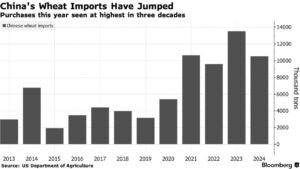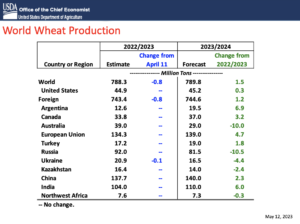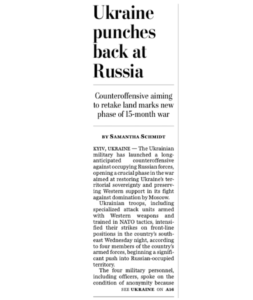The USDA is projecting that the ag trade deficit will shrink in FY2026 even more than previously anticipated. USDA expects the trade deficit to fall from $43.7 billion in FY2025…
China Will Feed More Wheat to Hogs; “El Nino Has Officially Returned,” and Ukraine “Counter-Offensive Gets Under Way”
Bloomberg writer Hallie Gu reported today that, “China will feed a lot more of its domestic wheat crop to hogs and poultry this year after heavy rains reduced the quality of the harvest in the biggest growing region, boosting prospects for imports.
The amount of wheat consumed in animal feed is likely to increase by 10 million tons to about 35 million tons in the year starting in July, with a large volume consisting of sprouted grain, according to the latest forecast from Shanghai JC Intelligence, a China-based commodity consultancy.
“The loss of high-quality wheat could increase demand for imports, with JC Intelligence raising its estimate by 1 million tons to just over 9 million tons in the coming year.

“Chinese buyers booked some Canadian wheat last week, and are actively making inquiries for more grain, according to traders, who asked not to be identified because they’re not authorized to speak publicly.”

The Bloomberg article added that, “‘Companies are expected to import more because it’s profitable, though the country’s huge stockpiles mean it doesn’t need to purchase much,’ said Ma Wenfeng, a senior analyst at BOABC, a Beijing-based agriculture consultancy. ‘If there are a lot of imports, it will weigh on prices and hurt farmers, which is not good for food security,’ Ma said.
“The consultancy [BOABC, a Beijing-based agriculture consultancy] predicts that the amount of wheat used for feed in the coming year will more than double to 27.5 million tons from 11.4 million tons a year earlier, according to its latest report. The country is expected to produce 140 million tons in the 2023-24 year, US Department of Agriculture data show.”
Reuters writers Ella Cao and Ryan Woo reported today that, “Non-stop heavy rain lashed parts of southwest China on Friday, triggering floods in some cities, engulfing roads and partially submerging buildings.”
“The central province of Henan, the granary of China, was recently struck by heavy rain that caused crops to sprout or be hit by blight, triggering concerns about food security,” the Reuters article said.
Meanwhile, Reuters writer Gloria Dickie reported yesterday that, “El Nino has officially returned and is likely to yield extreme weather later this year, from tropical cyclones spinning toward vulnerable Pacific islands to heavy rainfall in South America to drought in Australia and in some parts of Asia.”
Forecasters at @NOAA’s @NWSCPC announce the arrival of #ElNino https://t.co/2pYGBPzLOM pic.twitter.com/swA9gHPjbQ
— National Weather Service (@NWS) June 8, 2023
“Early signs of hot, dry weather caused by El Nino are threatening food producers across Asia, while American growers are counting on heavier summer rains from the weather phenomenon to alleviate the impact of severe drought,” the Reuters article said.
El Niño conditions are present and are expected to gradually strengthen into the Northern Hemisphere winter 2023-24. An #ElNino Advisory is now in effect. https://t.co/5zlzaZ0D9Z pic.twitter.com/KEkExCC3Hc
— NWS Climate Prediction Center (@NWSCPC) June 8, 2023
Dow Jones writer Paulo Trevisani reported yesterday that, “Wheat for July delivery rose 1.5%, to $6.26 1/4 a bushel, on the Chicago Board of Trade on Thursday, as forecasts of dry weather fueled expectations of lower supplies.”
Trevisani added that, “Soybeans futures scored a third consecutive daily rise, as uncertainty about upcoming rainfall stoked volatility in grains trade.”
Elsewhere, Reuters writer Maximilian Heath reported yesterday that, “Argentina’s current soybean harvest is nearing completion with total production expected to reach just 21 million metric tons, a major grains exchange said on Thursday, far below yields from previous years for the country’s main cash crop.
“Argentina is the world’s leading exporter of processed soybeans, as well as a major wheat and corn supplier to global markets, but a historic drought that began last year has slashed by half expectations for the 2022/2023 harvest.”
And Reuters writer Matthew Chye reported today that, “Chicago soybean futures were tepid on Friday and poised to post weekly gains amid supply concerns, following a drop in total production in top exporter Argentina.”
“Traders await the U.S. Agriculture Department’s World Agricultural Supply and Demand Estimates report due later on Friday,” the article said.
In other news developments, Financial Times writers Christopher Miller and Max Seddon reported yesterday that, “Kyiv has committed German-made tanks into battle against Russian positions in south-eastern Ukraine, launching the first heavily armoured assaults of its long-anticipated counter-offensive.”

And Samantha Schmidt reported on the front page of today’s Washington Post that, “The Ukrainian military has launched a long-anticipated counteroffensive against occupying Russian forces, opening a crucial phase in the war aimed at restoring Ukraine’s territorial sovereignty and preserving Western support in its fight against domination by Moscow.”





